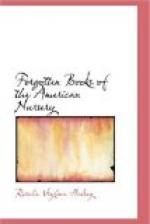Happily, many of the writers for little ones chose to be unknown, for it would be ungenerous to disparage by name these ladies who considered their productions edifying, and in their ingenuousness never dreamed that their stories were devoid of every quality that makes a child’s book of value to the child. They were literally unconscious that their tales lacked that simplicity and directness in style, and they themselves that knowledge of human nature, absolutely necessary to construct a pleasing and profitable story. The watchwords of these painstaking ladies were “religion, virtue, and morality,” and heedless of everything else, they found oblivion in most cases before they gained recognition from the public they longed to influence.
The decade following eighteen hundred and thirty brought prominently to the foreground six American authors among the many who occasioned brief notice. Of these writers two were men and four were women. Jacob Abbott and Samuel G. Goodrich wrote the educational tales, Abbott largely for the nursery, while Goodrich devoted his attention mainly to books for the little lads at school. The four women, Mrs. Sarah J. Hale, Miss Eliza Leslie, Miss Catharine Sedgwick, and Mrs. Lydia H. Sigourney, wrote mainly for girls, and took American life as their subject. Mrs. Hale wrote much for adults, but when editor of the “Juvenile Miscellany,” she made various contributions to it. Yet to-day we know her only by one of her “Poems for Children,” published in Boston in eighteen hundred and thirty—“Mary had a Little Lamb.”
Mary’s lamb has travelled much farther than to school, and has even reached that point when its authorship has been disputed. Quite recently in the “Century Magazine” Mrs. Hale’s claim to its composition has been set forth at some length by Mr. Richard W. Hale, who shows clearly her desire when more than ninety years of age to be recognized as the originator of these verses, In fact, “shortly before her death,” wrote Mr. Hale, “she directed her son to write emphatically that every poem in her book of eighteen hundred and thirty was of her own composition.” Although rarely seen in print, “Mary had a Little Lamb” has outlived all other nursery rhymes of its day; perhaps because it had most truly the quality, unusual at the time, of being told directly and simply—a quality, indeed, that appeals to every generation.
Miss Leslie, like Mrs. Hale, did much editing, beginning on adult gift-books and collections of housewife’s receipts, and then giving most of her attention to juvenile literature. As editor Miss Leslie did good work on the “Violet” and the “Pearl,” both gift-books for children. She also abridged, edited, and rewrote “The Wonderful Traveller,” and the adventures of Munchausen, Gulliver, and Sindbad, heroes often disregarded by this period of lack of imagination and over-supply of educational theories. Also, as a writer of stories for little girls and school-maidens, Eliza Leslie met with warm approval on both sides of the Atlantic.




